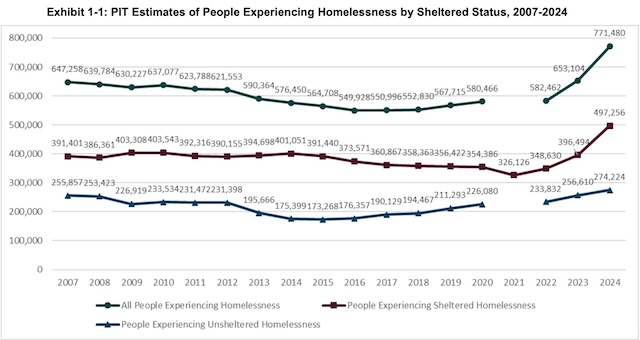The number of homeless people in the United States has grown by 33 percent since 2020, according to a report released last month by the Department of Housing and Urban Development (HUD). A chart on page 2 of the report (shown below) indicates that the number of homeless people was gradually shrinking between 2007 (when the annual homeless census began) and 2016, but then started rapidly growing in 2019 and even more rapidly growing in 2022.
Click image to download a 5.0-MB PDF of the report from which this chart was taken.
In the 1980s, groups and agencies worried about homelessness began programs aimed at treating drug and alcohol abuse, mental illness, and other conditions that led people to become homeless. More recently, low-income housing groups have advocating increasing spending on housing subsidies to provide shelter for homeless people. These two alternatives are known as “Treatment First” and “Housing First.”
Housing First has several political advantages over Treatment First. Housing First is a one-size-fits-all solution, which means there is no need to figure out whether someone is homeless because they lost their job, they are mentally ill, or they are a drug addict. Just build a shelter and stick them in it and declare victory.
A second advantage is that Housing First can be highly profitable to the groups building the housing. The federal, state, and local governments are collectively spending somewhere between $10 billion and $20 billion a year on affordable housing programs, and an average of 10 percent of that money — meaning well over a billion dollars a year — goes to “developer fees,” i.e., pure profit for the developers. The developers also charge rents for the housing they build, and while the rents may be below market, since most of the construction costs are paid for by taxpayers, most of those rents are profits as well. By comparison, Treatment First is not a huge profit center, which means the groups doing such practices do not have a lot of money to spend on lobbying and campaign contributions.
An objective view of these two approaches finds that each of them can benefit the people who take advantage of them. However, no one has seriously looked at whether either or both approaches can significantly reduce homelessness.
Instead, what we get are groups such as the National Low-Income Housing Coalition strongly promoting Housing First to the exclusion of Treatment First. The coalition is a non-profit group that spends about $10 million a year promoting housing policies. Its president receives more than $340,000 a year in compensation and at least five other staff members receive around $175,000 or more.
Another group, California YIMBY, promotes construction of affordable housing in somebody else’s backyard. Last week, MSNBC published an article by the group’s policy director, Ned Resnikoff, proclaiming the success of Housing First.
“Researchers have studied Housing First programs for decades,” Resnikoff says, “and have consistently found that they are effective in getting people stably housed.” However, the studies he cites only find that housing programs benefit the people who take advantage of those programs, not that such programs actually reduce homelessness.
In response, however, Resnikoff notes that the HUD homeless census found that the number of homeless veterans had declined by more than 50 percent since 2010, and he attributes that success to the Department of Veterans Affairs adopting a Housing First program. What he doesn’t say is that the VA program is not Housing First in the sense of government funding of affordable housing, which is what Resnikoff means by Housing First.
Instead, the VA program consists of a combination of rent vouchers with treatments for mental health, addiction, and other problems. In other words, it is closer to Treatment First than Housing First. It also lends support to my own analysis that found that rent vouchers were far more cost effective at helping low-income people than affordable housing subsidies.
Contrary to the claims of Housing First advocates, there is no silver bullet for curing homelessness, and Housing First is clearly not it. Tens of billions have been spent on affordable housing in the past four years and many cities have shifted from Treatment First to Housing First. The result has been the 33 percent rise in homelessness, showing that Housing First is a failure.









“Another group, California YIMBY, promotes construction of affordable housing in somebody else’s backyard.”
What does this mean?
These people don’t want housing first they want DRUGS first.
When government who runs your city, have a political motivation to pander to people who’re dysfunctional, poorly behaved, engage in lewd or self destructive acts, their policies do nothing but foster more dysfunctionality, poor behavior and lewd acts and disavowing self respect and personal dignity.
Now government admits to fining him…
Twice. Once and twice for being an asshole … by their standards.
I say this with heavy heart cities like, San Francisco and Portland will not be saved. Progressive policies that neuter cops and reward bad guys are but response to VOTER BASE. I wrote how low iQ groups cannot sustain a democracy or beneficial form of personal governance. Drug addicts occupy that bracket.
Victims of modern pharmacology, brain sizzling drugs knock iQ down 10 more points…..
Junkie 5 years on opiates is knocked down 10 iQ points
And addicts 7 more years borderline retarded.
They can’t work becuz task management and multitasking require training. That requires short and long-term memory which drugs have fried. They can’t be trained because they’re too dumb multitasking. They can’t be reintroduced to society because they can’t function without perpetual chaperone. They are babies. Adult babies. Violence, fanaticism, poor decision making, inept financial literacy follow these brackets. Geopolitical stability and personal freedoms cannot survive average iQ below 90. Lock up and leave.
janehavisham,
It means that, despite the name YIMBY, they don’t really want high-density developments in their backyards. They want to force other people to accept high-density developments in their backyards. Peter Calthorpe, the leader of the New Urbanist movement, lives in a 4,000-square-foot house on a 0.4-acre lot. You think he wants to put a New Urban development on his lot?
What makes people think that they have a right to dictate what kind of housing is appropriate in backyards that they don’t own?
If you don’t want high-density developments next to your property, just buy that property as well. Problem solved!